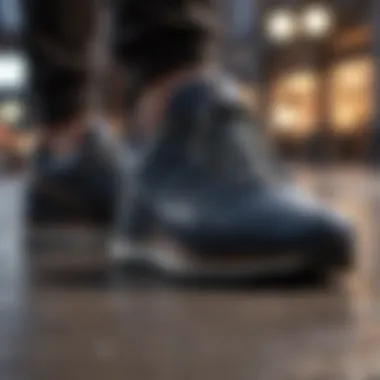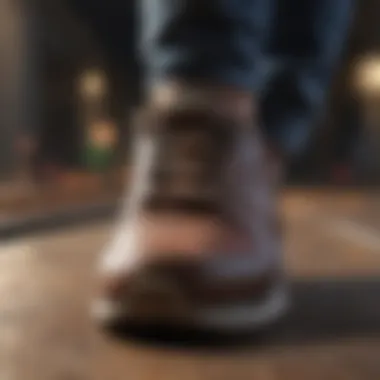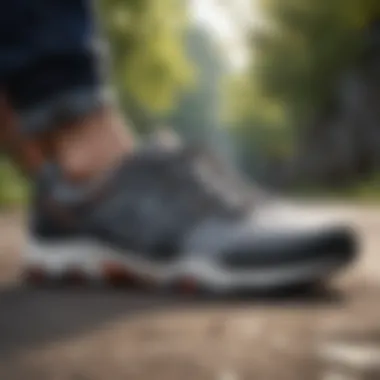Best Walking Shoes for Obese Individuals: A Comprehensive Guide


Intro
Walking serves as a fundamental form of physical activity. For obese individuals, it holds additional significance due to its low-impact nature on the joints. Choosing the right walking shoes is essential for various reasons. Proper footwear can provide the necessary comfort, support, and stability to facilitate a more enjoyable walking experience.
Many people overlook the importance of quality walking shoes. Often, they settle for any available option, neglecting how specialized footwear can enhance their walking routine. This article will explore key features that define effective walking shoes for obese people and present a curated selection of the best options available in the market.
In addition, the reader will gain insights into maintaining foot health while engaging in walking exercises. This article is aimed at health professionals, wellness coaches, nutritionists, fitness trainers, و mindfulness instructors. Each group can play a vital role in emphasizing the advantages of appropriate footwear for this demographic. Ultimately, the aim is to empower individuals with knowledge that enhances their overall well-being.
Key Takeaways
- Walking is a beneficial exercise that alleviates pressure on joints for obese individuals.
- The right footwear improves comfort and reduces the risk of injury.
- Key features to consider include cushioning, arch support, stability, and fit.
"Proper footwear is not just an accessory; it is a necessity that can dictate the success of your walking program."
Statistics
- According to the Centers for Disease Control and Prevention (CDC), over 40% of adults in the United States are classified as obese.
- A study found that wearing proper walking shoes can reduce the risk of foot injuries by as much as 60%.
Practical Tips
Steps for Choosing the Right Walking Shoes
- Cushioning: Ensure the shoes have adequate padding. This helps absorb shock and reduce impact on joints.
- Arch Support: Look for shoes tailored to your arch type, whether flat, neutral, or high. Proper support can enhance comfort.
- Sizing: It is crucial that shoes fit well. Consider trying them on in the afternoon when feet are slightly swollen.
Suggested Routine
- Regular Walking Schedule: Aim for at least 30 minutes of walking most days, adjusting as necessary.
- Foot Health Habits: Inspect feet regularly for any signs of issues, such as blisters or calluses.
- Shoe Rotation: Consider having more than one pair of walking shoes to allow for proper wear and tear.
By understanding and implementing these tips, individuals can foster a more effective walking experience. The right pair of shoes can enhance comfort, promote foot health, and encourage a consistent walking routine.
Understanding the Need for Proper Footwear
In the journey toward better health, the choice of footwear plays a crucial role, particularly for obese individuals engaging in walking. Proper footwear can enhance comfort and reduce the risk of complications arising from excess weight. It provides necessary support, making each step more manageable and pleasant. Therefore, understanding the need for suitable walking shoes is essential for anyone looking to improve their walking experience while maintaining their foot health.
Impact of Weight on Foot Health
Weight directly impacts foot health through increased stress on the joints and foot structure. The feet bear the burden of the entire body weight during walking, which can lead to discomfort and various conditions. It is observed that individuals with higher body weight often experience altered biomechanics. This shift can cause excessive pressure on the heel and forefoot areas, increasing the risk of injuries and pain. Aside from overall discomfort, long-term effects may include tendonitis, plantar fasciitis, and even arthritis in extreme cases.
Also, the arch of the foot may collapse under the weight. This condition, known as flatfoot, can lead to overpronation. Overpronation causes the ankle to roll inward too much, increasing strain on ligaments and muscles. Shoes that are not designed to counteract such effects may exacerbate foot problems, leading to a decline in mobility.
Common Foot Problems in Obese Individuals
Obese individuals may encounter several foot-related issues. These problems range from minor irritations to more severe conditions that require medical attention. Some common issues include:


- Plantar Fasciitis: This is a painful condition caused by inflammation of the tissue that runs along the bottom of the foot. Obesity increases stress on the plantar fascia, leading to discomfort.
- Bunions: These bony bumps occur at the base of the big toe and can be exacerbated by poor footwear choices and excess weight.
- Blisters and Calluses: Increased friction from walking can result in blisters and calluses, causing pain and discomfort.
- Heel Spurs: These are bony protrusions on the underside of the heel, often associated with plantar fasciitis.
- Diabetic Foot Issues: For obese individuals with diabetes, there is a heightened risk of foot ulcers and infections, making proper footwear essential for prevention.
Understanding these potential problems underscores the importance of selecting the right walking shoes. Proper footwear can minimize discomfort and protect against further complications, ensuring a more enjoyable walking experience.
Key Features of Walking Shoes
Choosing the right walking shoes is essential for obese individuals. The key features can significantly affect comfort and overall health while walking. These elements play a crucial role, from supporting the foot's structure to providing cushioning against impact. A proper understanding of these features helps in making an informed choice that enhances walking experiences, ensuring safety and reducing the risk of injury.
Arch Support
Arch support is vital for individuals with excess weight. It helps maintain the foot’s natural shape and reduces strain on the arches. This support alleviates pressure, particularly during extended periods of walking. Without adequate arch support, there's a higher chance of experiencing discomfort, which can lead to avoiding physical activity. It’s important to consider various arch types: flat, neutral, and high arches. A good shoe should cater to one’s specific needs, ensuring that weight is distributed evenly and reducing pressure points.
Cushioning
Cushioning is another key feature that aids in shock absorption. This is especially important given that each step creates impact on joints, particularly in obese individuals. Quality cushioning materials help mitigate this stress and provide a comfortable experience. Shoes with effective cushioning typically utilize materials like EVA or gel, which absorb shocks and enhance comfort levels. When assessing cushioning, it’s useful to consider how the shoe responds under different conditions, like walking on hard surfaces versus softer terrain.
Stability
Stability refers to the shoe's ability to provide support, preventing excessive movement during walking. Good stability is crucial for obese individuals, as it helps in maintaining balance and alignment. Shoes with a stable base can prevent rolling of the foot, which may lead to injuries. Stability features can include wider bases, firmer materials, and additional components like heel counters that help keep the foot secure. When choosing shoes, look for those marked with stability features for an enhanced walking experience.
Durability
Lastly, durability should never be overlooked when selecting walking shoes. Given the added stress of weight, shoes must withstand significant wear and tear over time. High-quality materials and robust construction contribute to a longer lifespan. Brands that offer warranties or are known for durability can be more trustworthy options. Investing in shoes that last not only saves money but also ensures that proper support and comfort continue throughout their use.
Understanding these key features – arch support, cushioning, stability, and durability – is essential for obese individuals as they can lead to better walking experiences and improved foot health. Walking should be a pleasant activity that contributes to overall well-being.
Evaluating Fit and Sizing
Evaluating fit and sizing is a crucial aspect when selecting walking shoes for obese individuals. The right fit can impact comfort, support, and overall performance during walking. Properly fitting shoes help distribute body weight evenly, reducing excessive pressure on specific areas of the foot. This is especially important for individuals with a higher body mass, as improper fit can lead to avoidable injuries or discomfort.
Importance of Proper Fit
Wearing shoes that fit well serves several purposes. Firstly, it ensures that the foot is supported adequately. This reduces the risk of conditions such as plantar fasciitis, which is common among obese individuals. A good fit also prevents blisters and other irritation, which can occur when shoes are too tight or loose. Moreover, the right fit boosts confidence in mobility. When one wears shoes that feel good, they are more likely to engage in physical activities, such as walking. This engagement is paramount, as regular walking can lead to significant health improvements.
Measuring Your Foot Correctly
Measuring one’s foot accurately is essential. Many people underestimate the importance of this step and presume they know their size. However, foot sizes can change due to factors like weight fluctuations and age. The correct way to measure involves several steps:
- Gather Materials: You will need a ruler or measuring tape and a piece of paper.
- Prepare Your Foot: Stand up straight on the paper and ensure your weight is evenly distributed across both feet.
- Trace Your Foot: With a pencil, trace around your foot, keeping the pencil upright.
- Measure the Length: Use the ruler to measure the length from the heel to the longest toe.
- Check the Width: Measure the widest part of your foot to find the width size.
This process will yield accurate measurements, so one can correlate them with size charts from various brands. Comparing these measurements helps ensure that you select shoes that properly accommodate your foot's unique shape. By taking the time to measure your foot correctly, you are setting yourself up for a more comfortable and healthier walking experience.
Top Brands Specializing in Walking Shoes for Obese Individuals
Selecting the right walking shoes is a fundamental aspect of ensuring comfort and health for obese individuals. The shoes worn during walking can greatly influence the overall experience, from ease of movement to impact on foot and joint health. Top brands focus specifically on crafting shoes that cater to the unique needs of this demographic. Understanding which brands excel in this area can serve as valuable insight for anyone looking for appropriate footwear.


Overview of Popular Brands
Various brands have established themselves as leaders in the market of walking shoes tailored for obese individuals. Some of the notable names include:
- New Balance: Known for its emphasis on comfort and support, New Balance offers footwear with specific sizing and width options.
- ASICS: This brand is recognized for its advanced cushioning technology, promoting shock absorption, which is crucial for heavier walkers.
- Brooks: Brooks specializes in running and walking shoes that prioritize stability and motion control, catering directly to the needs of obese individuals.
- Skechers: With a variety of models emphasizing comfort and lightweight designs, Skechers often appeals to those who prioritize ease of wear.
- Hoka One One: This brand stands out for its maximalist designs offering exceptional cushioning, which can enhance walking experiences significantly.
These brands bring specific strengths to the table, ensuring that individuals can find suitable options that meet their personal comfort and support requirements.
Features Offered by Leading Brands
When considering walking shoes of these brands, a few key features regularly stand out:
- Arch Support: High-quality arch support is essential in preventing foot fatigue and providing stability.
- Cushioning: Effective cushioning helps to absorb impact during each step, reducing stress on joints.
- Wide Fit Options: Many prominent brands offer a range of width sizes to accommodate different foot shapes, a benefit not commonly available in standard sizes.
- Stability Techniques: Advanced designs focus on controlling motion, preventing overpronation, which is common among obese walkers.
- Durability: Shoes from notable brands tend to feature high-quality materials that resist wear over time, making them a more economical choice in the long run.
"Choosing shoes from reputable brands is not just about style; it's about health and well-being, especially for those who carry extra weight."
Whether it’s walking around the block or embarking on longer treks, investing in well-regarded brands that specialize in features for obese individuals can lead to a notably improved walking experience.
Reviews of the Best Walking Shoes
Evaluating different walking shoes is essential, especially for obese individuals. The right shoes can significantly improve comfort and mobility while walking, contributing to a more active lifestyle. This section highlights various shoe models, discussing their unique features and gathering insights from users. Understanding these models helps individuals align their choices with personal needs, whether that means focusing on cushioning, arch support or durability.
Shoe Model One
Key Features
The ASICS Gel-Kayano shines in key areas like cushioning and arch support. The shoe's gel technology absorbs shock, reducing the impact on joints, which is crucial for those with increased weight. The added stability helps prevent overpronation, a common issue among overweight individuals. While it effectively supports movements, it may feel somewhat heavier compared to other models, which is worth considering.
User Feedback
When observing user feedback, many reviewers highlight the comfort level of ASICS Gel-Kayano. They often mention how quickly they adapt to this model, finding it suitable for long walks. Some drawbacks noted include the price point, which is higher than some alternatives. However, users typically agree the investment is worthwhile due to the significant benefits gained.
Shoe Model Two
Key Features
The Nike Air Monarch IV features a cushioned midsole that aids in shock absorption. Its broad fit makes the shoe accessible for many users regardless of foot shape. One downside might be the aesthetic, as some find it lacking in modern style. Still, practicality and comfort take precedence for many people, outweighing design considerations.
User Feedback
Feedback regarding the Nike Air Monarch IV reveals a large base of satisfied customers. Users frequently mention its long-lasting wear, with many appreciating its value for money. Users tend to note that while it may not be the most fashionable option, the comfort achieved during walks compensates for it.
Shoe Model Three


Key Features
New Balance 990v5 excels in several areas like stability and arch support. It includes an ENCAP midsole technology which brings a combination of stability and comfort together quite well. The downside to this model, though, can be its weight, as it is slightly heavier than other alternatives on the market, necessitating some adjustment.
User Feedback
User feedback indicates that the New Balance 990v5 garners strong approval from those who prioritize comfort during long walks. Its reputation among fitness professionals highlights its capacity to reduce foot fatigue over extended periods. A common criticism involves the cost, but many agree that the quality justifies the price.
Maintaining Foot Health While Walking
Maintaining foot health is essential for everyone, particularly for obese individuals who may experience greater stress on their feet during walking. The right approach helps in preventing injuries and discomfort, which can be deterrents to engaging in regular physical activity. This section focuses on specific foot care practices and considerations for when to replace walking shoes, providing a comprehensive guide that promotes sustained well-being.
Foot Care Practices
Healthy feet are the foundation of a good walking routine. Proper foot care practices can help address common issues and improve overall foot health. Here are several key practices to consider:
- Regular Cleaning: Keep feet clean and dry to prevent fungal infections. Daily washing with mild soap and ensuring thorough drying is crucial.
- Moisturizing: Apply lotion to the feet but avoid the areas between toes to prevent moisture buildup. This step helps maintain skin elasticity and prevents cracks.
- Checking for Problems: Regularly inspect your feet for any unusual signs such as blisters, sores, or discoloration. Early detection can prevent more serious issues.
- Foot Exercises: Simple stretching and foot exercises can strengthen foot muscles. This may help in reducing fatigue and improving overall foot function.
- Choosing the Right Socks: Select breathable, moisture-wicking socks that prevent blisters and provide cushioning. This choice enhances comfort during walking.
Following these practices offers significant benefits. They help in reducing the risk of injuries, promoting better circulation, and ensuring overall comfort during walking.
When to Replace Walking Shoes
Walking shoes play a pivotal role in maintaining foot health. Over time, shoes lose their supportive structure, leading to an increased risk of injury. Knowing the signs that indicate when to replace your walking shoes is vital:
- Visible Wear: Inspect the outsole of the shoe. If there is uneven wear, or the tread is worn out, it is time for a replacement.
- Loss of Cushioning: If you start to feel more impact when walking, it might indicate that the cushioning has degraded. Shoes should provide shock absorption and comfort.
- Cracks or Damage: Check for cracks in the material. Any severe damage compromises the shoe's integrity and support.
- Age of the Shoe: Even if shoes appear to be in good condition, they generally need to be replaced every 300 to 500 miles of walking.
- Changes in Comfort: If you notice discomfort, pain, or other issues while walking that were not present before, it might be time to assess your shoes.
Keeping walking shoes in good condition not only helps maintain foot health but also enhances walking effectiveness.
Culmination
In any discussion regarding the best walking shoes for obese individuals, the conclusion serves as a vital element that encapsulates the core messages of the article. It is essential to reflect on the information provided while emphasizing the significance of appropriate footwear for enhancing comfort and performance during walking tasks.
Recap of Key Points
To summarize, proper footwear is not just a matter of style or preference; it significantly impacts health. The following key points emerge from the discussions throughout the article:
- Understanding Foot Health: Weight can profoundly affect foot health, leading to various conditions if not properly managed.
- Key Features: Arch support, cushioning, and stability are critical components in designing suitable walking shoes for individuals with higher body weight. These features provide the necessary support to mitigate stress on the feet.
- Fit and Sizing: Not only does having the right size matter, but understanding individual foot dimensions can lead to a better experience and reduce discomfort.
- Brand Choices: There exist several reputable brands that specialize in crafting shoes catering to the specific needs of obese individuals, such as Brooks and New Balance.
- Maintenance Practices: Regular foot care and timely replacement of walking shoes are essential to maintaining foot health and enhancing overall walking functionality.
These points highlight the essential considerations a buyer should keep in mind when making their selections.
Encouragement for Active Living
Encouraging active living is a central theme here, as engaging in regular physical activity, such as walking, can lead to significant health improvements. Walking helps with weight management and increases cardiovascular health, reducing the risks of diseases associated with obesity.
The adoption of proper walking shoes can provide not only support but also confidence. When individuals feel comfortable in their footwear, they are likely to walk more frequently, thus enriching their overall quality of life.
Taking the first step towards an active lifestyle can begin with the right pair of shoes.
By prioritizing foot health and understanding the importance of proper footwear, obese individuals can embark on their walking journey with more assurance.
To conclude, navigating through the complexities of choosing the best walking shoes is as important as the act itself. Emphasizing comfort, support, and durability in footwear can make a difference in motivating individuals to lead a more active and fulfilling life.







